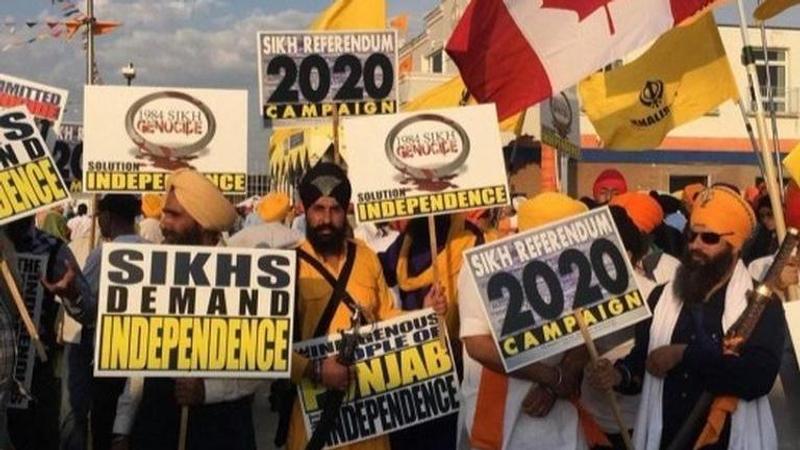Published 14:20 IST, October 3rd 2018
What is the Khalistan secessionist demand?
The Khalistan demand is an extremist demand for the breaking up of India for the formation of a seperate nation state for those of the Sikh religion. The Khalistan demand took its most virulent form in the 1980s. As per SATP, the violence and terrorism surrounding the Khalistan demand consumed as many as 21,469 lives before the movement was comprehensively defeated in 1993.

The Khalistan demand is an extremist demand for the breaking up of India for the formation of a seperate nation state for those of the Sikh religion. The Khalistan demand took its most virulent form in the 1980s. As per SATP, the violence and terrorism surrounding the Khalistan demand consumed as many as 21,469 lives before the movement was comprehensively defeated in 1993.
Pakistan's ISI has been fomenting and assisting the revival and resurgence of the extremist movement in 2018.
Khalistan in Punjabi means the “Land of the Khālsā” or “pure”. Khalistan stems from the ideology for an autonomous Sikh nation as a result of secession from India.
WHAT IS THE HISTORY BEHIND IT?
While the idea of a seperate Sikh state first appeared in a pamphlet by Dr Vir Singh Bhatti in 1940 as what seems to be a counter to the Muslim League’s Lahore Declaration, it did not gain momentum until much later. The call for Khalistan emerged as a violent secessionist movement in the 1970s and 1980s. The demand for a separate state or Khalistan, received support from organisations like the All India Sikh Students’ Federation and were led by Jarnail Singh Bhindranwale. The violence led to standstill in Punjab for over a decade.
First, there was Jagjit Singh Chauhan, who after serving as the Finance Minister in Punjab in the 1960s decamped to London in 1971 to run a Khalistan government in exile. He , infamously, took out a full page advertisement in the New York Times in 1971 where he proclaimed the formation of a separate Sikh state, the Republic of Khalistan. He tried to set up a government-in-exile in Pakistan and from the UK in the early 1980s when he appointed himself as the President of Khalistan.
Parallely, in India a violent Khalistan movement led by Jarnail Singh Bhindranwale was gaining momentum. Khushwant Singh recalls how Bhindranwale would make radicalising, hateful and provocative speeches and in one such speech “he exhorted every Sikh to kill 32 Hindus, not 31, not 33 – only 32 he said.”
It was as part of the Khalistan movement that Lala Jagat Narain, the Hindu owner of the Hind Samachar group of newspapers, was assassinated by Sikh terrorists on 9 September 1981 for writing about reporting Hindi instead of Punjabi.
But, what was possibly the worst face of the call for Khalistan, was the Kanishka Bombing by a terror group called Babbar Khalsa. On June 23, 1985, a bomb exploded aboard Emperor Kanishka or Air India Flight 182, flying on the Montreal-London route, with New Delhi as the final destination killing all 329 on board.
Operation Blue Star took place in 1984 to eliminate Sikh terrorists like Bhindranwale who were living and had fortified the complexes of the Golden Temple with armed followers. The military operation was launched under the instructions of the Prime Minister Indira Gandhi as a means to quell the deterioration of law and order in Punjab. By the 1990s, the Khalistan movement and the violence that came with it saw a downward by spiral and had all but disappeared.
WHY HAS IT SEEN A RESURGENCE TODAY?
An organisation called the Sikh Federation of Justice has launched a propaganda campaign calling for a referendum for a separate state by 2020. The website of the referendum claims the “Punjab Referendum 2020 is a campaign to liberate Punjab, currently occupied by India.” The group held a rally on August 12, 2018 at Trafalgar Square in London, only to be overshadowed by Indian societies organising 'We Stand With India' and 'Love My India' events to counter the pro-Khalistan rally.
While the MEA issued a demarche to the UK regarding the malicious Referendum 2020 campaign, the sitting Chief Minister of Punjab has dismissed the referendum as Pakistani propaganda. He had said “They have been at it for long and have been playing into the hands of the ISI, which has an open agenda to foment trouble in Punjab and India."
Pakistan has launched an all out effort to stoke violence and create a divide within India by reigniting radicalisation in the name of the Khalistan demand. On April 16th this year, the MEA lodged strong protest at “attempts being made during the ongoing visit of the Sikh pilgrims from India to Pakistan to raise the issue of ‘Khalistan' by making inflammatory statements and displaying posters at various places of pilgrims visit in Pakistan.”
THE POLITICAL CONNECT TODAY
The Khalistan demand has been used as a basis to polarise by some politicians even today. AAP leader Sukhpal Singh Khaira batted for the break up of India with the formation of Khalistan and tried to claim that “those demanding a referendum are within their right.” Meanwhile, Shiromani Akali Dal leader Manjeet Singh GK was attacked by a group of Khalistan supporters in New York on August 20th and at the Yuba City Gurdwara in California on August 25th this year.
The resurfacing of the pakistan propagated Khalistan demand has also been linked to the killings of BJP and RSS leader in the state of Punjab. In May this year, the NIA chargesheeted 15 members of the banned Khalistan Liberation Force for the murder of Rashtriya Swayamsevak Sangh leader and BJP worker Ravinder Gosain in Ludhiana.
Updated 14:20 IST, October 3rd 2018




